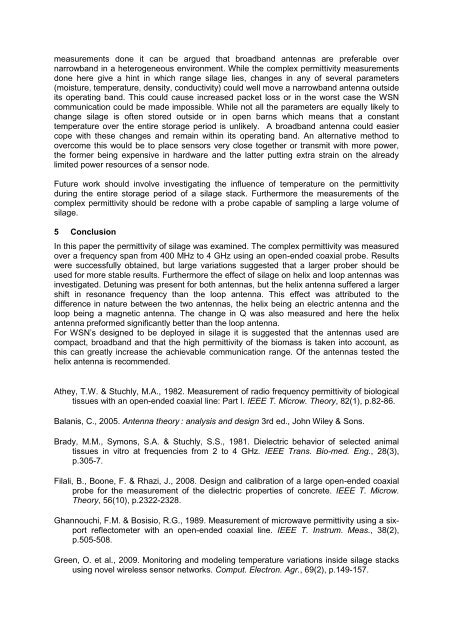ORAL - International Conference of Agricultural Engineering
ORAL - International Conference of Agricultural Engineering
ORAL - International Conference of Agricultural Engineering
You also want an ePaper? Increase the reach of your titles
YUMPU automatically turns print PDFs into web optimized ePapers that Google loves.
measurements done it can be argued that broadband antennas are preferable overnarrowband in a heterogeneous environment. While the complex permittivity measurementsdone here give a hint in which range silage lies, changes in any <strong>of</strong> several parameters(moisture, temperature, density, conductivity) could well move a narrowband antenna outsideits operating band. This could cause increased packet loss or in the worst case the WSNcommunication could be made impossible. While not all the parameters are equally likely tochange silage is <strong>of</strong>ten stored outside or in open barns which means that a constanttemperature over the entire storage period is unlikely. A broadband antenna could easiercope with these changes and remain within its operating band. An alternative method toovercome this would be to place sensors very close together or transmit with more power,the former being expensive in hardware and the latter putting extra strain on the alreadylimited power resources <strong>of</strong> a sensor node.Future work should involve investigating the influence <strong>of</strong> temperature on the permittivityduring the entire storage period <strong>of</strong> a silage stack. Furthermore the measurements <strong>of</strong> thecomplex permittivity should be redone with a probe capable <strong>of</strong> sampling a large volume <strong>of</strong>silage.5 ConclusionIn this paper the permittivity <strong>of</strong> silage was examined. The complex permittivity was measuredover a frequency span from 400 MHz to 4 GHz using an open-ended coaxial probe. Resultswere successfully obtained, but large variations suggested that a larger prober should beused for more stable results. Furthermore the effect <strong>of</strong> silage on helix and loop antennas wasinvestigated. Detuning was present for both antennas, but the helix antenna suffered a largershift in resonance frequency than the loop antenna. This effect was attributed to thedifference in nature between the two antennas, the helix being an electric antenna and theloop being a magnetic antenna. The change in Q was also measured and here the helixantenna preformed significantly better than the loop antenna.For WSN’s designed to be deployed in silage it is suggested that the antennas used arecompact, broadband and that the high permittivity <strong>of</strong> the biomass is taken into account, asthis can greatly increase the achievable communication range. Of the antennas tested thehelix antenna is recommended.Athey, T.W. & Stuchly, M.A., 1982. Measurement <strong>of</strong> radio frequency permittivity <strong>of</strong> biologicaltissues with an open-ended coaxial line: Part I. IEEE T. Microw. Theory, 82(1), p.82-86.Balanis, C., 2005. Antenna theory : analysis and design 3rd ed., John Wiley & Sons.Brady, M.M., Symons, S.A. & Stuchly, S.S., 1981. Dielectric behavior <strong>of</strong> selected animaltissues in vitro at frequencies from 2 to 4 GHz. IEEE Trans. Bio-med. Eng., 28(3),p.305-7.Filali, B., Boone, F. & Rhazi, J., 2008. Design and calibration <strong>of</strong> a large open-ended coaxialprobe for the measurement <strong>of</strong> the dielectric properties <strong>of</strong> concrete. IEEE T. Microw.Theory, 56(10), p.2322-2328.Ghannouchi, F.M. & Bosisio, R.G., 1989. Measurement <strong>of</strong> microwave permittivity using a sixportreflectometer with an open-ended coaxial line. IEEE T. Instrum. Meas., 38(2),p.505-508.Green, O. et al., 2009. Monitoring and modeling temperature variations inside silage stacksusing novel wireless sensor networks. Comput. Electron. Agr., 69(2), p.149-157.
















